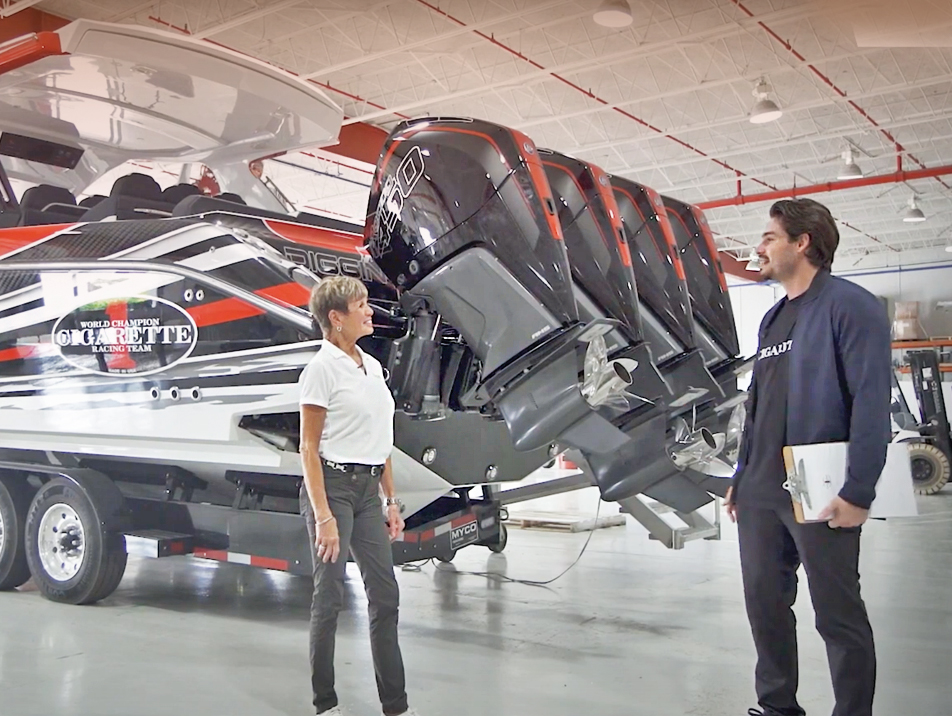Boat Building Basics: Fiberglass, Resin, Composites And Cores
A look at basic boat construction, fiberglass technology, and the fundamentals that modern boat builders use.
Many people wonder how modern fiberglass boats are built, and boat building today is not at all like it was back when antique and classic powerboats were built. These days, boat building is actually pretty high-tech. In boats.com's Factory Fridays video series we tour boating’s top manufacturing facilities across America. The in-depth series gives viewers exclusive access to the innovators and craftsmen behind some of the best boat brands in the world and a firsthand look at the latest boat building techniques and materials used inside their plants.
Above: From innovative marine propulsion systems and cutting-edge onboard technology, to the advanced physics of computerized hull design, boat builders share their fascinating stories and unique approaches to constructing and engineering a variety of watercraft in the Factory Friday video series from boats.com.
- Boat Building Basics
- Modern Boat Building Techniques
- Types Of Fiberglass Resin
- Types Of Fiberglass Cloth
- Advanced Composite Construction
- Boat Core Materials
- Advanced Boat Building Techniques
- Monohull Versus Catamaran Construction
- Alternative Boat Building Methods
Boat Building Basics
Prior to the development of fiberglass construction techniques, boats were built of wood, steel, and other materials, by assembling pieces and parts into a structure which was then sheathed with a hull. With fiberglass boat building, however, the major components of the boat – the hull, deck, liner, and large parts like consoles—are molded from fiberglass. Usually, this means starting with a female mold. The mold is first sprayed with gelcoat, then fiberglass cloth is applied, and then resin is used to saturate or “wet out” the fiberglass. When the resin cures, you have a hull or a boat part (for an explanation of the different boat parts, see our Beginner’s Guide to Boat Terminology).
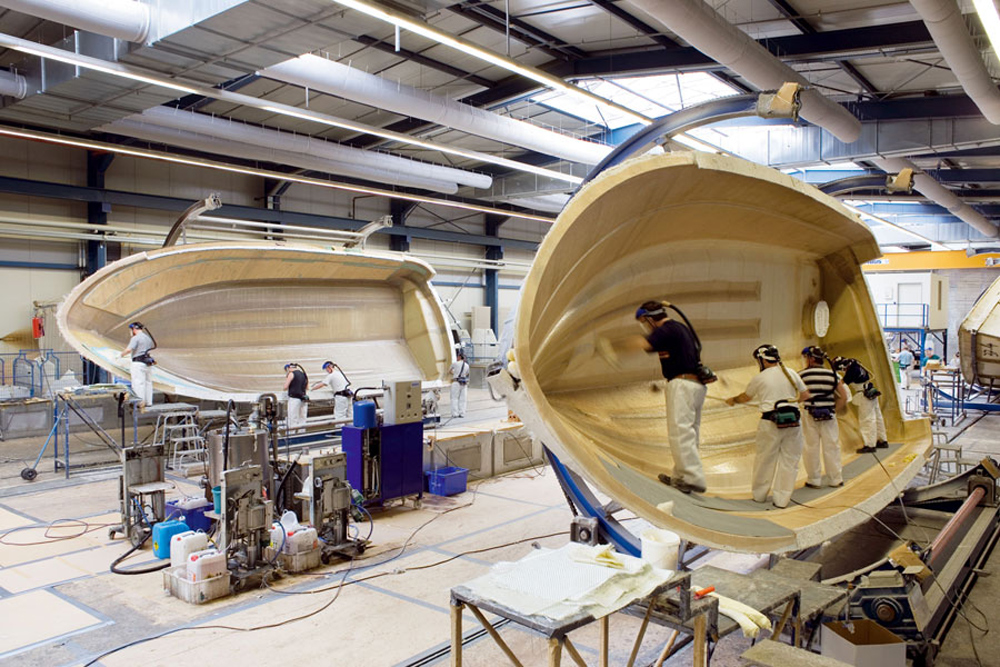
Above: In the modern age, building a boat begins with a mold. These molds will be used to create Bavaria powerboats. Photo by Bavaria Boats.
Structural reinforcements like stringers and bulkheads can be molded separately and then fiberglassed to the part, or may in some cases be laid up at the same time. While the hull is still open and exposed, items that will be located below deck level like fuel and water tanks or inboard engines can be mounted. This is also when plumbing and wiring may be run. Then the major components are assembled. For most modern powerboats, that means the deck and/or liner is lifted, often with a crane, and lowered into the hull.
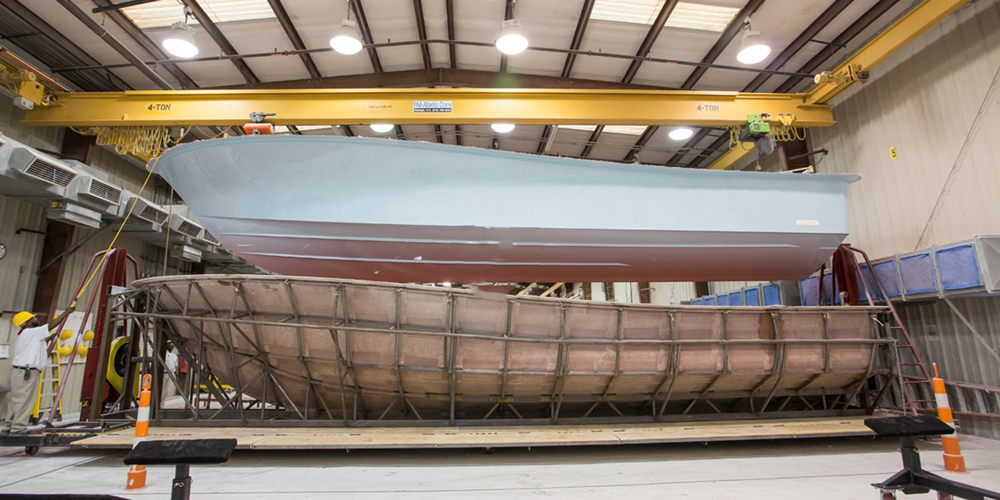
Above: Overhead cranes are often used to lift major boat parts, like this hull for a Regulator fishing boat, out of the molds and into position for further assembly. Photo by Regulator Boats.
Many boats are designed with a “shoe-box” joint where the hull and deck have mating flanges, or overlap one another. Often mechanical fasteners such as screws or through-bolts are used to secure the parts together, in addition to the use of a chemical bonding agent and sealant like methyl methacrylate or 3M 5200, which also makes the joint water-tight. Additionally, some builders fiberglass around the perimeter of the hull to deck joint.
With the major parts of the boat assembled, interior fittings like seats and steering wheels can then be added. Finally, the details and finishing touches can be taken care of.
Changes In How To Build A Boat
The first revolution in modern boatbuilding was obviously the shift from mostly wood to mostly fiberglass construction, but a second one has been much more subtle. There has been a transition from conventional fiberglass methods to a host of exotic materials and techniques which can befuddle even the experienced yachtsman with buzzwords and jargon.
The concept remains essentially the same, however. Fiberglass (properly called Fiberglass Reinforced Plastic, or FRP) is still a fiber material set in a binding substance of resin. In the very early years, fiberglass was literally fibers of glass, but that soon changed to fibers of various synthetic plastics. For many years, a fiberglass construction has been from cloth, roving, mat, and resins you can buy in any hardware store. More recently it came to include more advanced materials like Kevlar and carbon fiber, which many people are familiar with from their use in other products. Today, however, there are so many different materials being used that a degree in chemical engineering is helpful when reading the brochure for a new boat.
Some of the advances came from the efforts of the builders of offshore racing powerboats and ocean racing sailboats to produce lighter, stronger, and therefore faster boats, but the real impact came with the energy crisis. Since fiberglass is a petrochemical product, it made sense for boat builders to investigate ways to make boats lighter without any loss of strength, because every pound of fiberglass eliminated saved the builder money. For powerboat builders, a light but strong boat is also more fuel efficient.
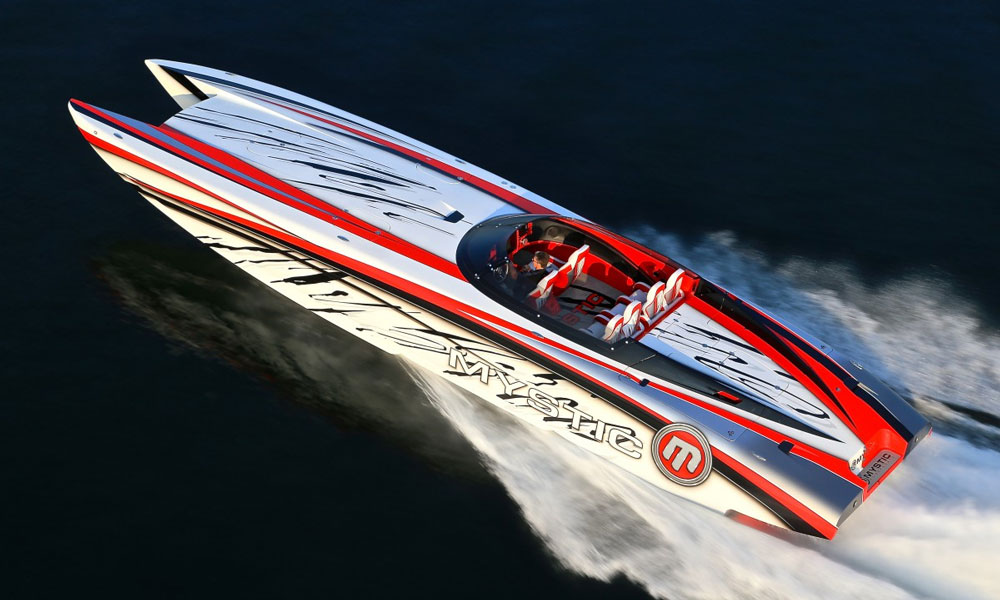
Above: The development of serious speed boats, like this Mystic catamaran, played a significant role as manufacturers learned how to minimize weight. It was the cost of construction, however, that spurred on this trend among boat-builders of all types. Photo by Mystic Powerboats.
Much of the research and development actually came from the aircraft and aerospace industries, where strength and light weight have always been prime concerns, and the trickle down of technology has become such a waterfall that many boat owners are unaware of the changes taking place in both new materials and new molding techniques.
Types of Fiberglass Resin
There are three types of resins: polyester, vinylester and epoxy. Each has a place in the boat-building world. The important factor is for the builder to correctly match the resin to the type of reinforcing material being used so that the strengths are matched. For example, a vinylester resin is ideal for S-glass but, when used with E-glass, the reinforcing material will fail before the resin.
Polyester
This is the resin most commonly used for boatbuilding today, and most boat owners are familiar with it. It is inexpensive and generally all-purpose. It has low stretch (elongation) properties so it is not used on modern high-performance boats, but it is perfectly adequate for most boats. The most common polyester is an orthophthalic base, but newer isophthalic based polyesters are gaining in popularity. The isophthalics are more resistant to water and chemicals, are more abrasion resistant, and have higher impact and fatigue (flex) performance. Most modern gel coat finishes are made with isophthalic resins.
Vinylester
An alternate to polyester, vinylesters have better stretch characteristics than polyesters, so they more closely match the strengths of the various exotic reinforcements. Vinylester also has good water resistance and fatigue properties, but it is more expensive than polyester resin. One important feature of vinylester is that it has excellent secondary bonding strength, so bulkheads or stringers added to a cured hull will have a better bond than on a polyester hull.
Epoxy
This is high-performance resin, with a matching price tag. Epoxy resins have had a reputation for being hard to work since early epoxies were thick, but many modern epoxies are quite liquid. Epoxy will adhere better than any other resin to a wide range of materials, which makes it ideal for attaching cores, stringers, or other items.
Types of Fiberglass Cloth
Woven fabrics using continuous strands are the most common cloths, with weights ranging from four to 15 ounces per square yard. Heavier weights, usually called roving or woven roving, consist of untwisted yarns of fiber in weights that range up to 48 ounces per yard. The finished roving resembles a coarse burlap and, like all cloths, has good bi-directional strength. The lighter cloth weights can be found in a variety of weave patterns, such as twill, satin and matt, for different purposes.
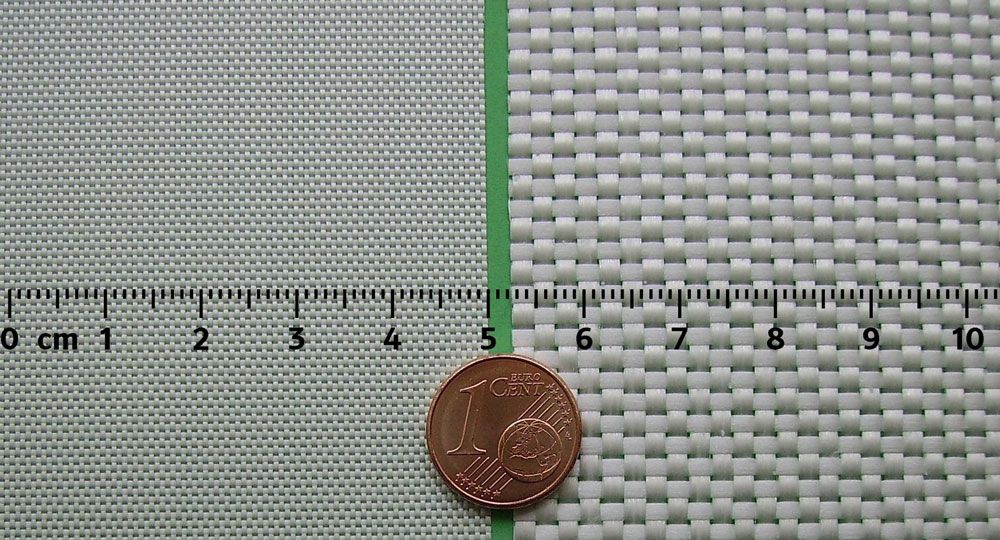
Above: Two examples of fiberglass cloth: the fiberglass at the left is significantly thinner and lighter, but provides less stiffness.
E-Glass
This is the most commonly used fiberglass cloth in boatbuilding today. You can buy E-glass at a marine supply store, and bond it with polyester resin. It is made from molten plastic spun into fine fibers that are then either woven into cloth or loosely gathered into roving.
S-Glass
This is high performance fiberglass cloth from the aircraft industry. It is three to five times more expensive than E-glass, but it is also much stronger. Developed by Owens-Corning, it has 20 to 40 percent higher tensile, impact, and flexural strength than E-glass. There are two types of S-glass: S-1, which meets critical aerospace standards and is blindingly expensive; and S-2, which is used in the marine industry. In Europe, S-glass is called R-glass.
Mat
Mat is usually made of E-glass, and consists of random two- to three-inch fibers held in place by a binder that is resin soluble. Mat is used primarily for building thickness and stiffness into fiberglass layups. Mat resists "print-through," where the weave of roving shows in the outer layer of the hull, but it also soaks up a tremendous amount of resin and is low in strength for its weight.
Uni-Directional Fibers
This is one of the advances in reinforcing materials. It consists of strands of fiber running in one direction only, held together by single fibers that are glued or sewn laterally, much the same way that a bamboo fence is held together by a few wires. Obviously it has very high directional strength, so it can be used in areas where the loads are specific. Because it is not woven, there are no kinks and it’s easier for workers to wet out with resin since it doesn't hold air like a cloth fabric.
Bi-Axial Fibers
Technically most cloth is bi-axial, but the modern definition means a fabric made from layers of unidirectional cloth that are not woven through each other. One layer simply lays atop the next layer to produce a kink-free band of fiber.
Tri-Axial Fibers
This is a layered material similar to bi-axial cloth, except that the fibers are oriented in three directions, often at 120 degrees to each other to spread the loads.
Advanced Composite Construction Materials
Carbon Fiber
These fibers of graphite provide superb stiffness as well as high tensile and compression strengths and are often used in conjunction with S-glass or other exotics to provide acceptable impact resistance, which is otherwise quite low. Carbon fiber is very expensive, but it can outperform metal in many situations. Many companies produce carbon fiber worldwide and the usages depend upon the carbon content of the fiber itself, with some being intended for high strength applications and others being aimed for high modulus (stiffness) situations. It is the most expensive type of fiber reinforcement available, costing as much per pound as 100 times common E-glass. Second only to Kevlar in specific strength, carbon fibers are superior to any other fiber in stiffness.
Carbon fiber has come to the forefront of modern boat building with increasing number of boat builders utilizing these materials thanks to their strength and lightweight characteristics. With boats built with carbon fiber, honeycombs of this material are laid into flat ribbons that get woven into a cloth just like fiberglass. The resulting matrix is bonded together with vinylester resin, making an ultra-lightweight and sturdy material. Viking Yachts is one of the leading builders in the boat building industry using this technique and helping to pioneer it further, as is Nor-Tech. The boats are stronger, lighter and stiffer than traditional fiberglass boats. Of course this type of construction and the materials required are very expensive and adds greatly to the overall cost and price of the vessel.
Kevlar
The trademarked name for a DuPont product, it is used to refer to aramid fibers of which DuPont is the sole producer worldwide. An aromatic polymid (usually shortened to aramid), Kevlar is a form of nylon that was originally developed in the mid-1960s as "Fiber B" to reinforce radial tire belting. It's unique properties soon were put into other uses, and the public usually thinks of Kevlar in terms of bullet-proof jackets. There are, in fact, two forms of Kevlar available. Kevlar 29 is used for lines, cables, and flak jackets, while Kevlar 49 is used as a reinforcement fiber in plastic composites.
On a strength to weight comparison, Kevlar has the highest specific tensile strength of any commercial fiber. It is five times stronger than steel and twice as strong as E-glass, which allows a Kevlar hull to maintain the same strength as an E-glass hull at a fraction of the weight. Impact strength is also a Kevlar forte, and it is able to withstand repeated impacts as well as resist the tendency of other reinforcing fibers to allow cracks to spread. The negative side to Kevlar is a marked weakness in compression strength, so it is often used in conjunction with other fibers that balance that trait.
Above: Nor-Tech Boats is a notable boat brand featured in Factory Fridays EP. 6 that uses high density foam combined with kevlar and carbon fiber interlaced into the fiberglass with a heavy duty reinforced transom to allow for larger outboard engines and great horsepower.
Nomex
A chemical developed by DuPont, Nomex is most famous for its fireproof qualities, and it is used in fire-resistant suits for firemen and race car drivers. It is an aramid, which is turned into a paper-like substance for use in honeycomb.
Hybrids
These are reinforcing fabrics that combine two or more different types of fiber. One common hybrid is a mixture of Kevlar with carbon fiber. The Kevlar provides high impact resistance, while the carbon fiber supplies the stiffness. Combinations of S-glass, Kevlar and carbon fiber are also available to optimize certain properties at minimum cost.
Boat Core Materials
Core materials are often used to reduce weight and increase stiffness. Some builders core the entire boat; others construct with solid fiberglass from the waterline down and coring above, and still others use some mix of coring and solid glass throughout the boat.

Above: You can see the core (with checkered appearance) in this part, about to be vacuum-bagged at Sabre Yachts. Photo Credit: Sabre Yachts.
Balsa Core
When first used as a hull stiffener boat builders laid long planks of balsa into the hulls, but this method led to rot and structural failure when water "wicked" through the entire plank. It's taken balsa a long time to live down this beginning, but modern balsa is now a widely accepted coring material in boats. The solution came from slicing through the grain, turning it on edge, and producing a checkerboard pattern of end-grain pieces that do not transmit water. The result is a stiff, light and inexpensive core with good impact quality and high compressive strength. An added feature is the insulation quality of balsa against sound, thermal change, and vibration. One negative factor is that balsa can absorb resin, making the hull heavier, but quality workmanship can keep that from happening.
PVC Foams
Airex and Klegecell (pronounced kledge-a-cell) are the most popular commercially produced foam cores that are used today. Both are closed cell foams made from polyvinyl chloride, but each has different characteristics. Airex is a non cross-linked PVC, making it more flexible and resistant to damage. Klegecell is a cross-linked foam that is extremely rigid. Foreign-built boats often use Divinycell, a Scandinavian version of Klegecell.
Honeycomb
Honeycomb is just what it sounds like: a waffle-like pattern of material to give the highest stiffness of any core of equal weight. The compression and shear strengths are second to none, which might be expected from a material originally used in aircraft for flooring and bulkheads. Nomex honeycomb is the most commonly found on yachts, although it is definitely a high-ticket extravagance for owners in search of the last ounce of weight savings. Surprisingly enough, some honeycombs are made of paper. A kraft paper is impregnated with resins and then formed into a honeycomb, making it water resistant as well as sturdy, but the paper honeycomb is heavier than Nomex. "Skinned panels" are ready-made sheets of honeycomb resembling a piece of plywood, and are available with teak veneer or various other overlays that can be cut into ready-made honeycomb bulkheads.
Get some insight into how core works inside a fiberglass part by watching our Understanding Foam Cored Boat Construction video.
Advanced Boat Building Techniques
Along with these new materials, methods of laying them up into what will eventually become a boat have also advanced in recent years. Again, minimizing weight while maximizing strength is virtually always the goal.
Vacuum Bagging
: This process begins like an open molding layup, but the wet laminate is enclosed in a plastic film and a vacuum is applied to draw out excess resin. Excess resin doesn’t add strength – that’s what the fiberglass is for – but it does add weight. So the vacuum bagging process reduces the boat’s eventual weight without sacrificing any strength.
Vacuum Infusion
The vacuum infusion process similarly incorporates plastic film and a vacuum to attain an ideal resin-to-glass ratio. However, rather than beginning with a wet lay up the vacuum, along with a set of resin feeding lines, introduces and draws the resin through the cloth in the first place. This allows for a more precise measurement of the materials and the ability to apply even pressure across a large area, so you can lay up larger parts.
For a simplified explanation of how the vacuum process works when molding boats, watch our Understanding Vacuum Bagging video.
Monohull Versus Catamaran Construction
Catamarans are very costly to build, as of course they require two hulls to be constructed and joined together. Generally monohulls tend to be cheaper when compared to their catamaran counterparts. Virtually all modern catamarans are made with fiber-reinforced-polymer (FRP) construction techniques. Catamarans are often intended as bluewater cruisers - or boats that can handle the water conditions out in the open ocean. Thus they need to be very sturdy and durable so that they are able to take a beating and keep passengers safe. Catamaran bulkheads are larger and must be able to take greater loads than a monohull. Closed cell foam, isophthalic resins and high-resistance polyester are commonly used to reinforce these substructures.
Above: Featured in Factory Fridays EP. 8, Twin Vee PowerCats has been designing and building American-made catamaran boats for over 26 years, crafting vessels that are known for their safe, reliable twin-hull design that make for reliable, sturdy offshore fishing boats at an affordable price.
Alternative Boat Building Methods
While the vast majority of the recreational boats built today rely on these materials and methods, there are exceptions. Most often you’ll find them with large yachts, where price is no object. Some are still built with metal hulls, some with wood and some others with techniques like “cold molding,” or “plank on frame.” Let's explore some of these unique boat building methods.
Cold Molding
The cold molding construction process attaches two or more wood “veneers” to a pre-fabricated "jig" in order to create the shape of the boat's hull. Using epoxy resin, these veneers are glued together and the outer hull is generally reinforced with layers of fiberglass and epoxy resin for added strength, both outside and inside. Virtually all Custom Carolina sport fish yachts are built with this construction method.
In these cases the structure of the boat is crafted from wood which is then layered with or encapsulated in hand-laid fiberglass and epoxy resin. Sportfishing yachts like a Bayliss 73 foot convertible, and high-end cruisers like Vicem yachts, are built with these methods. Other well-known boat builders who use cold molding to construct their vessels include names like Jarrett Bay, Spencer, Merritt and Weaver Boatworks, to name a few.
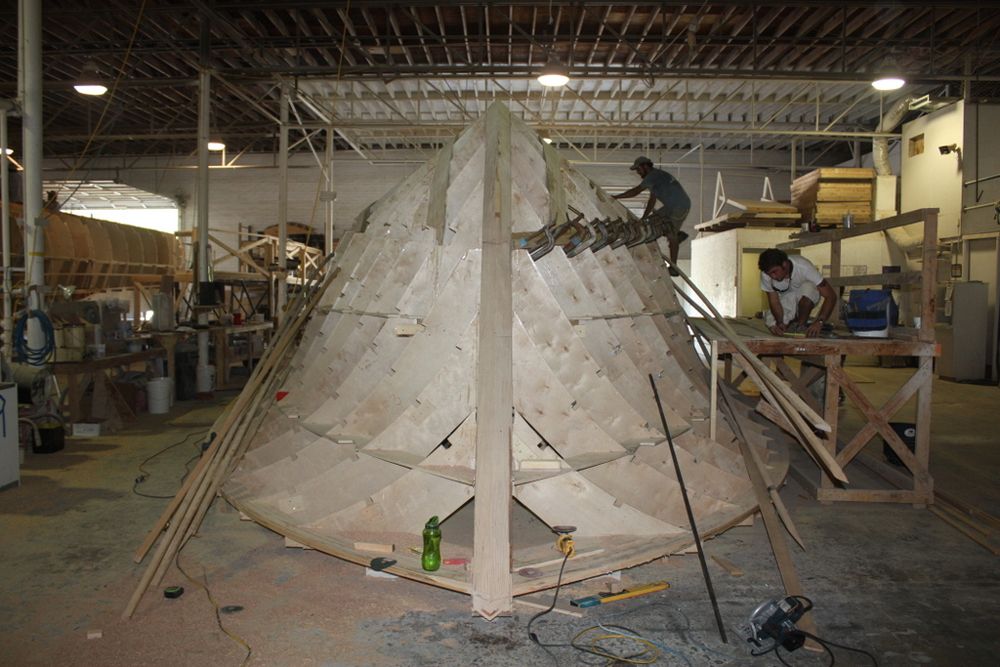
Although many modern boatbuilders eschew the use of wood, on high-end custom yachts like this Jarrett Bay, methods like cold molding are often considered superior to more modern techniques.
At the opposite end of the extreme, you have FRP boats without the F or the R and only the P – plastic. Though the largest all-plastic boats in production are under 20 feet in length (and most are under 12 or 14 feet) roto-molded plastic has become quite popular in the kayak and dinghy markets. These simple, inexpensive craft are formed from plastic pellets which are melted down inside of a rotating oven, which is also a mold. When it cools, the plastic has taken the mold’s shape and a boat pops out.
Clearly, building a boat is a huge project that also represents a large financial undertaking no matter what technique and materials are used. Some materials are more expensive and some techniques take much longer than others. Boat building is a beloved tradition throughout the country and world, shared by many cultures over thousands of years. The design and construction of vessels is a labor of love that involves a tremendous amount of manual labor, skill and dedication. Remember, boats aren’t just a form of transportation - they are feats of engineering and design that can capture our imagination and allow us to enjoy the incredible freedom that the world's oceans, lakes and rivers can bring to life.
Now that you know the basics of modern boat building and you’re ready to choose a boat of your own, be sure read How to Buy a Boat: Tips for First Time Buyers.
Editor's Note: This article incorporates portions of a Basic Boat Construction article by Chris Caswell, from August of 2000, and was last updated in February 2022.










